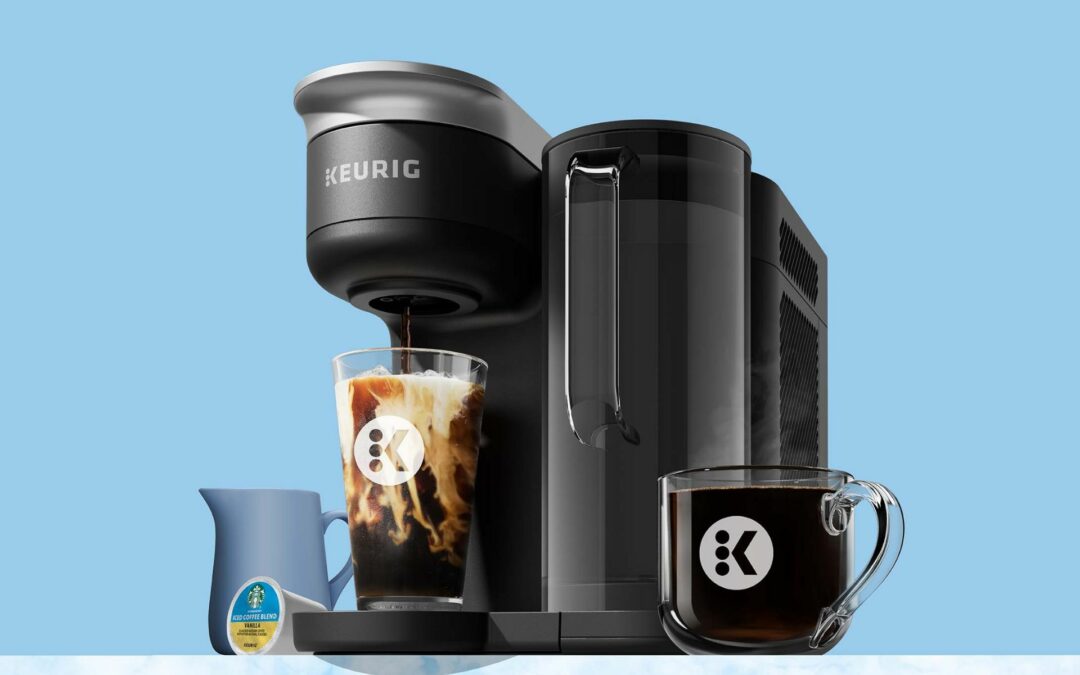Walmart corporate leadership recently appeared at a pair of annual analyst meetings and provided a fresh perspective on recent activity and the direction of the Walmart and Sam’s Club businesses. The executives outlined a plan to boost general merchandise, including home, and to add more locations for a warehouse operation that has been gaining significantly in recent years.
Although Walmart does quarterly conference calls in association with its earnings releases, the analyst meeting appearances provide additional details and color beyond the typical discussion associated with financial releases.
In Walmart’s second-quarter conference call, Walmart President and CEO Doug McMillon reiterated a theme that value and convenience are key advantages that draw a warm response from Walmart customers in the United States and beyond.
“Around the world, our customers and members are prioritizing value and convenience,” McMillon said in introducing another quarter of strong financial results from the company.
However, that wasn’t all the news. At the time of its quarterly financial release, the company also announced that it had appointed Sam’s President and CEO Kath McLay to the same post for Walmart International to replace a retiring Judith McKenna. The decision isn’t too surprising considering the strong results Sam’s posted during McLay’s tenure at the warehouse club operation.
Analyst meeting presentations by John David Rainey, Walmart’s executive vice president and CFO, and McLay, then Sam’s CEO, touched on operational initiatives and developments, including membership programs, advertising offerings, the role of private label, store growth and the positioning of general merchandise at a time when many customers have switched spending with the company to food and other everyday needs.
The presentation by McLay provided a chance to gain a deeper sense of what’s going on with Walmart’s wholesale club business. As discussed, Sam’s, which closed 60 clubs not long ago in an effort to reset the business, now plans to open about 30 as sales and memberships grow, priming the unit for continued expansion as it makes internal changes to align store and online operations. Sam’s is bringing the experience of shopping the physical sales floor closer to its online shopping platform with its Scan & Go service, McLay indicated, giving Sam’s the capability to engage in store in the same kinds of interactions consumers undertake online.
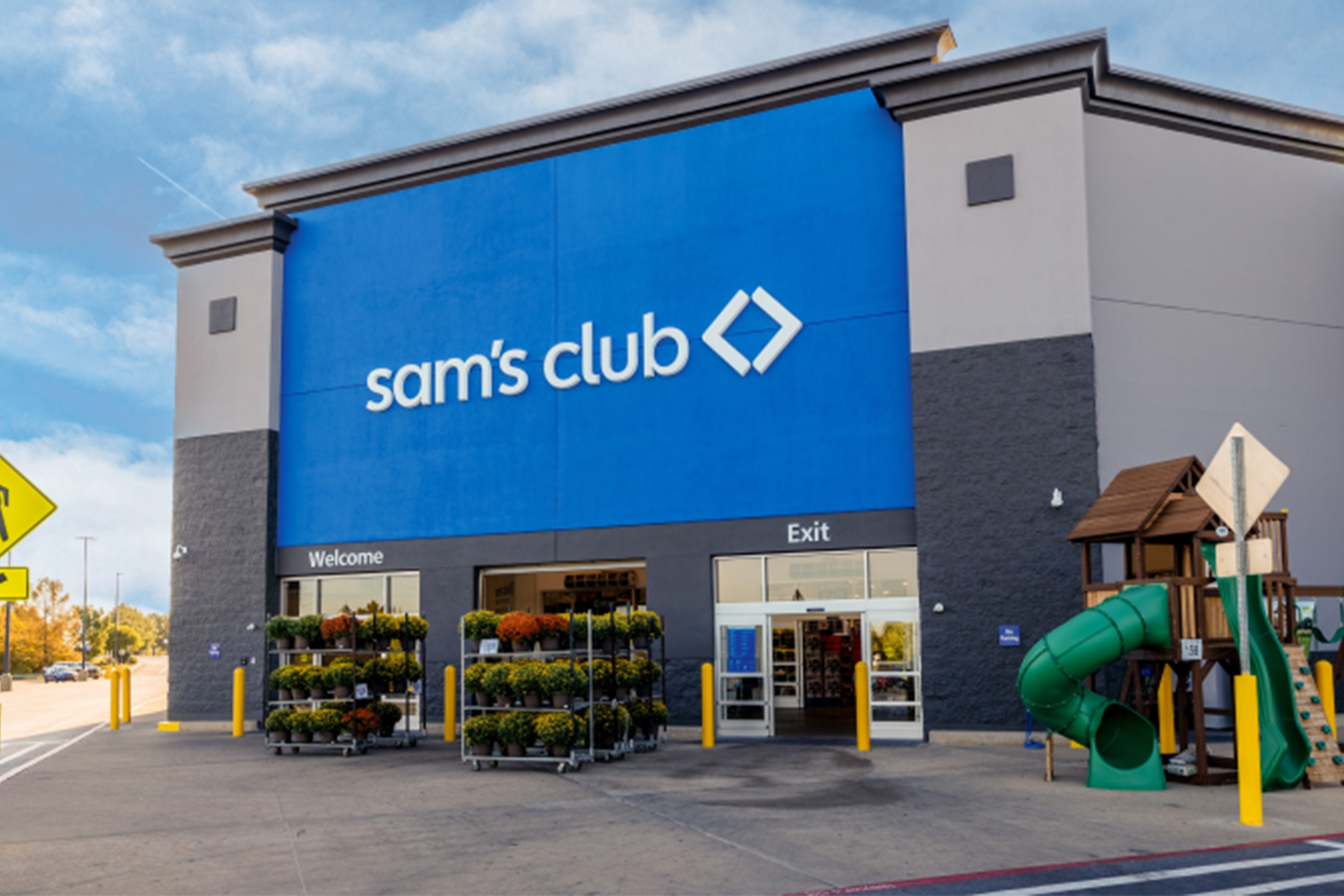
Sam’s Club exterior
As part of the Evercore ISI Consumer & Retail Conference, Rainey acknowledged gains in traffic and comps at Walmart stores are largely due to higher growth in food and consumables. As consumers feel inflationary pressure on their wallets, they’ve been slower to make discretionary purchases, particularly of big-ticket items. By providing value and convenience, Rainey said, Walmart has experienced share gains overall and in grocery operations. As it enjoys more robust growth from services such as store delivery and pickup, Walmart’s convenience becomes a more important operational element. In Walmart’s last completed quarter, grocery delivery and buy-online-pick-up-in-store were up 40% year-over-year, and such gains have been ongoing.
Still, inflation, even if it has been declining, is a reality faced by Walmart customers, causing substantial increases in the price of a typical market basket shopped. Rainey said the company had tried to accommodate customers the best it could by working with suppliers on prices and providing private-label goods as another way for consumers to save.
“Our mission is to provide the very best pricing for our customers that we can,” Rainey said. “And so we work with our suppliers to try to make that happen. But we’ve got a big private brand business with Walmart U.S. Greater than 20% of our sales are in private brand items, and, in Sam’s, it’s close to 30%. So this is a good vehicle to be able to provide value to our customer.”
Rollback Role
Steph Wissink, Walmart senior vice president, investor relations, added Walmart has used rollbacks to provide better pricing for consumers looking to the company for everyday needs. Walmart has been specific in how it uses those tactics, however, she said. An example is providing pricing on the components of a typical holiday meal that matched what Walmart charged a year earlier.
“We carried that all the way through our spring marketing campaign, and it’s proven to be really effective for us, not only in driving customer engagement but also reinforcing our position,” Wissink said. “And I think we’re gaining some goodwill among consumers right now, in addition to overall working very closely with our suppliers to make sure that their dollars are the most effective for them to drive the volume they need as well. So it’s a continuation of what we’ve been doing, and what’s been working, but you’re going to see more of that as we get into the back half of the year. Back to school is a really important point for us to reinforce that value proposition, and then you’ll see that continue into the fall and holiday season.”
In the company’s April fourth-quarter conference call, McMillon said Walmart would put a particular focus on boosting the home and apparel presentations to win consumer purchase consideration while lifting overall margin given the better profits available in such categories. Rainey continued on that theme.
Certainly, pursuing food and consumables needed to be a focus. The consumer shift to food and consumables under the pressure of inflation provided less margin opportunity but a better chance of winning market share.
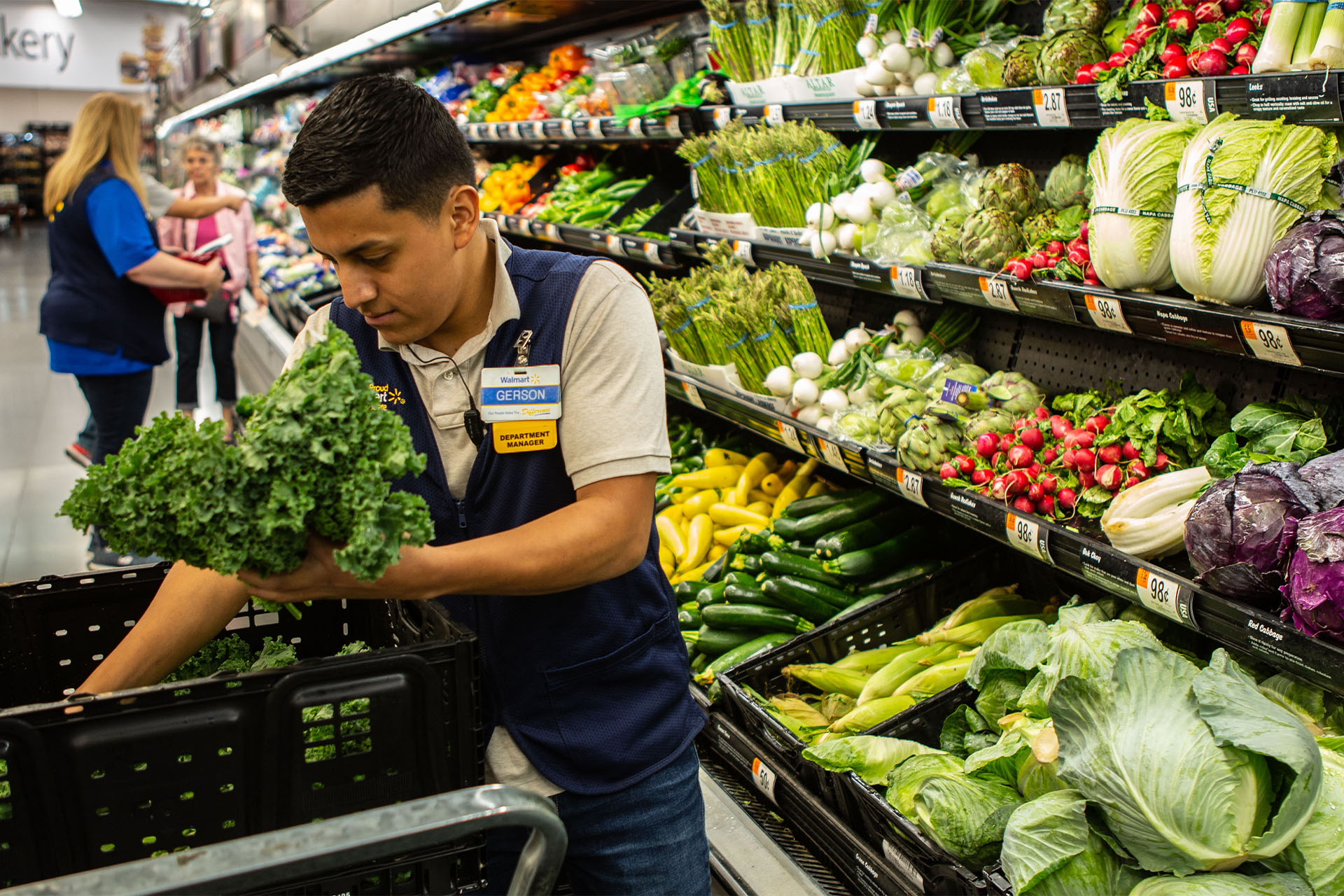
Walmart employee stocking produce section
Recently published Numerator data indicating that Walmart captured considerable consumables omnichannel market share in all regions of the United States. It captured a 15.6% share in the Northeast, 24.1% in the Midwest, 27.1% in the South, and 15.8% in the West. Numerator pointed out the West is the only region in which Walmart does not capture the highest consumables omnichannel market share. The leader in the West is Costco with a 17% share compared to Walmart’s 15.8%.
Longer term, Walmart wants to build back margin. Rainy said Walmart has been assessing and bolstering general merchandising because it positions Walmart for its next phase of growth when the goal is to increase margins faster than sales. Although other aspects of the business, from domestic services such as advertising and international enterprises, factor into the profit picture, Walmart is working to enhance general merchandise in stores, via e-commerce and through marketplace sellers. Marketplace offers Walmart an opportunity to expand and deepen its product assortment. As such, Walmart is creating its own endless aisle to help customers discover items that best address their priorities and to put it into a stronger position versus its main general merchandise competitor, Amazon.
Supply Chain Changes
Walmart is looking at supply chain as another opportunity. It is making a “tremendous investment” in supply chain, Rainey said, with moves to improve unit economics around fulfillment by about 20% in five years. In as little as three years, Walmart plans to have 65% employing automation to goods movement. Efforts to improve supply chain will not only save money but also improve product flow to the consumers and satisfaction, the company said.
Still, Wissink noted, Walmart expects its workforce level to remain stable over the next few years. Walmart will redeploy employees to different jobs and establish upskilling initiatives to give Walmart the opportunity to enhance customer service or work with automated systems, which has the potential to improve employee satisfaction as well as customer service.
Walmart is interested in employee recruitment, satisfaction and retention in a tight labor market in which people have options and training, given more worker interaction with digital systems, which can be more extensive and expensive. The company has invested significantly in wages over the past few years, Rainey pointed out, but it also is creating career paths, filling 88% of positions above entry level with existing employees.
“We’re giving someone the opportunity to advance,” he said. “That’s really important as people think about their own wealth creation and career growth at Walmart.”
In competitive terms, Rainey said Walmart is comfortable with its price gaps today. Back in time a bit further, he said, Walmart decided to invest in price in response to the dynamic competitive environment. Today, pricing remains an issue in an ever-changing retail environment, but Rainey said Walmart had put money where the company felt it should. Now, he said, Walmart believes it is in the right position without the need to make major new investments.
In the United States, Rainey said the retailer is beginning to hit its stride on some critical initiatives beyond basic retailing. These include advertising, fulfillment services and data ventures.
Advertising is, he said, “a big opportunity. When you look at what some of our competitors are doing in terms of their advertising dollars relative to their GMV and then you look at Walmart, you would argue that we are way under-penetrated. But I think the important thing for us, if you think about any digital business, is the challenge is scale and scaling those opportunities out. Well, we’re starting today with scale. We’ve got hundreds of millions of customers that come to Walmart each week. And if we can leverage that with these digital opportunities, it gives us a real advantage.”

John David Rainey, Executive Vice President and Chief Financial Officer, Walmart
We’ve got hundreds of millions of customers that come to Walmart each week. And if we can leverage that with these digital opportunities, it gives us a real advantage.
– John David Rainey, Executive Vice President and Chief Financial Officer, Walmart
Rainey noted advertising can be a significant boost to Walmart financially, but the company has to take into consideration customer experience. Balancing revenue generation and customer sensibilities, Walmart looks to avoid over-rotating and eroding shopper satisfaction.
Rainey said Walmart can get better at some of its newer capabilities especially understanding customers and what constitutes great buying experiences that encourage consumers to come back with frequency and shop the banner across multiple channels. He admitted Walmart is less advanced than some of the leading companies in its customer research but regards that as an opportunity for improvement, which it is pursuing.
In the main retail business, Rainey said, Walmart’s newest remodels are generating sales gains of as much as 20% even though they only represent a small percentage of the store base at the moment. Rainey called the remodeled stores, “a different Walmart. You go to it with improved waypoint finding, signage, wider aisles and displays around apparel. And it really has a different look and feel as well as additional brands that we haven’t traditionally carried. And so we’re quite excited about it.”
Even if sales settle back as the remodeled stores’ newness becomes less of a factor, Rainey said a gain of even a few percentage points long-term makes the remodeling effort a highly accretive ROI initiative for Walmart.
Loyalty Considerations
Loyalty has been a concern of Walmart recently, and it has been doing more to encourage it.
The Walmart+ membership program, Rainey said, is in its opening stage of development, but it already is drawing a younger, more tech-savvy and affluent shopper versus the retailer’s typical customer. The program is designed to provide the convenience important for Walmart’s development as a retail proposition, and Rainey pointed out that about 50% of Walmart+ members use pickup and delivery services.
Walmart+, he said, gives the retailer the chance to become more digitally engaged with customers. The data gleaned helps Walmart better understand customers and, as a result, tailor more relevant offerings to them than is possible with conventional customer research.
Walmart wants to continue adding more value and utility, and the retailer believes it has room for improvement in the membership program to give consumers more benefits that justify the membership fee.
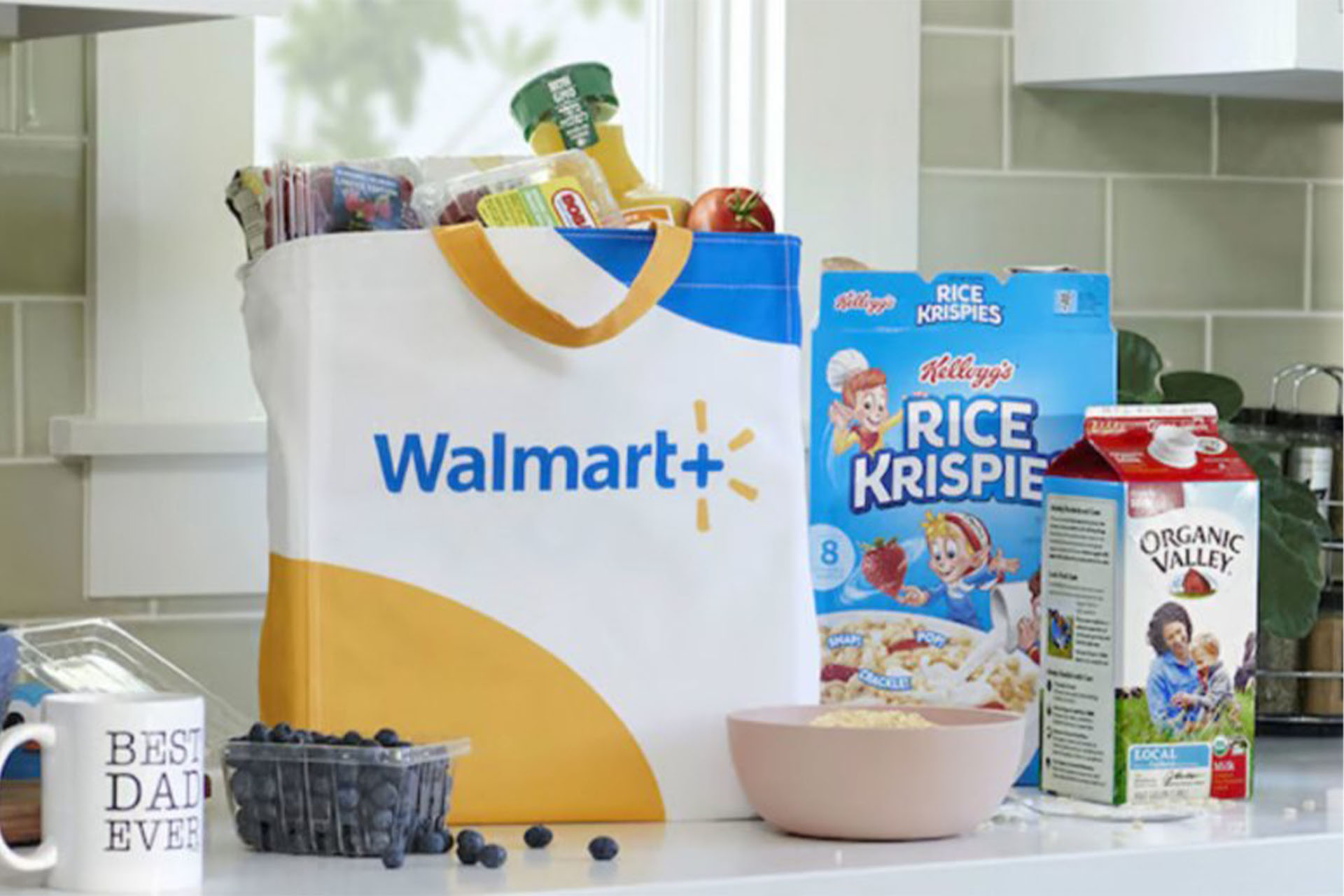
Walmart+ grocery delivery
Wissink added that a unique aspect of the Walmart+ approach is the co-creation experience it provides customers. The feedback loop built into the program is helping Walmart add value not only by saving customers money when they have items delivered but also by living better through such benefits as deals on streaming services and access to special promotions.
Rainey said the customer lifetime value of a Walmart+ member is appreciably higher than that of a non-participant because members shop more frequently and spend more money.
Sam’s Turn
Although Walmart had to revise how it positioned Sam’s Club a few years ago, the company has seen that business evolve successfully, setting up new initiatives to further advance the business.
Sam’s is a lower-margin business, he said, but if you look at the last three years, it has experienced tremendous growth with strong comparable store gains. Sam’s capitalized on some good opportunities, Rainey said, with digital engagement emerging as an important element in the banner’s development. Sam’s Scan and Go service, giving the customer the chance to use a mobile device to tally their selections and check out without getting online has resonated with club members, he said. About one in four of Sam’s transactions is accomplished via Scan and Go.
At the Baird 2023 Global Consumer, Technology & Services Conference Sam’s CEO McLay provided an outlook that includes adding more stores and the use of technology to keep up engagement with members.
When Walmart posted its annual results in February, Sam’s comparable sales, excluding fuel, were up 10.5%, on top of a 9.8% gain in the previous fiscal year. Sales were $84.3 billion and operating income was $2 million. Operating income was actually down a bit to $2 billion from $2.3 billion as consumers shifted to lower-margin everyday needs. Membership income increased 7.1% with member count at an all-time high. In fiscal 2019, when McLay took over leadership, sales were $57.8 billion, down 1.4% year over year with comps up 3.8% and net income up to 1.5 billion from $900 million in the year earlier.
Although operating income lagged, the number was the second-highest operating income since McLay took over the operation.
With 600 retail locations in 44 states and Puerto Rico, Sam’s represents about 14% of Walmart’s total revenue and has come off a run of three consecutive years when it posted double-digit core comps. Sam’s turned 40 earlier this year.

Kath McLay, President & CEO, Sam’s Club
Sam’s enjoyed strong membership growth the three years past, McLay said. She said it’s important to realize that Sam’s is attracting a “much younger demographic” that’s driving sales growth. That demographic is more digitally engaged with Sam’s and more likely to have joined in the regular course of business rather than through a promotion. McLay said Sam’s intends to cultivate that group because it has a chance to serve such consumers through ensuing life stages.
Although younger consumers are particularly value-conscious, Sam’s made the decision recently to raise its membership fee.
“It was probably one of the most agonized-over decisions we’ve made as a leadership team,” McLay said. “Putting your membership fee up during an inflationary period felt like a tough decision to make. But we’d also known over the last few years, we’d invested so heavily in the value prop that the time was right. And so, we looked at it and we thought, okay, how do we do this in a way that’s going to help us safely land this fee increase? And we also at the same time had just unlocked Sam’s Cash. So, for our Plus members, they get 2% back. Historically, they got that back annually in a check. And we knew that like, if they got it back, and it was below a certain amount, they’re more likely to spend it in the club. And if it was above a certain amount, it’s more likely to lose it to leakage outside of the club.
“And so what we wanted to do is look at: how do we actually reward members by giving them their Sam’s Cash monthly and how do we make this something that makes the relationship a bit more digitally sticky. And so, we unlocked the Sam’s Cash tracker and monthly distributions on our app, about the same time we were looking at the membership fee increase, so we decided what we’d do is lift the fee, but give them Sam’s Cash back to negate the increase, so that really it felt like we’re putting the fee up, but it’s on us for the first year. And that’s helped us get traction with Sam’s Cash. And we’ve seen negligible, if any, reduction in renewal as a result of it. So, that’s an all-around win for us.”
Inflation Fighting
Sam’s has been working to limit the effects of inflation on its members. She said Sam’s attracts a higher income demographic than what is typical in the mass market sector, which has proved helpful in mitigating the effects of inflation on the banner. Sam’s is adjusting its general merchandise lineup to ensure price points fit with what members expect of the club.
McLay characterized 2023 as an “interesting year” with multiple drivers affecting consumers at the same time.
“I think one of the primary things we’ve seen the last few years is members wanted to secure inventory,” McLay said. “So, whether it was play equipment, whether it was toilet paper, whatever it was, as soon as you put it out in the club, it sold. And we were finding that those seasonal dates were kind of blurring a little bit, and we were having to land inventory a lot earlier. This year, we’re seeing a snapback to more like a 2018 profile. People are waiting closer to the point of need or event before they purchase. So, our demand profiles are looking quite different. We’re also seeing members are very deliberate about how they spend their money, and particularly about large price-point purchases. So, I think we’re having to kind of watch and just keep an eye on those price points. So, it’s not that they’re not buying the higher price points, but we’re keeping an eye on it, because their behaviors are changing slightly.”
Sam’s plans to add more clubs after determining to close 60, or about 10% of the store portfolio, in 2018. In January, Walmart announced it planned to open about 30 new Sam’s clubs across the U.S. the next several years, with the first new location set to open in Florida during 2014. The company also has initiated a multiple-year plan to invest in and modernize the supply chain through new distribution and fulfillment center locations across the country that will employ cutting-edge automation. Sam’s will launch five new supply chain fulfillment and distribution centers in 2023, with the first location planned for a third-quarter open in Georgia during the third quarter.
Although the store count will be down from its peak even after adding 30 locations, the company has boosted sales and operating income despite having 60 fewer locations now than it did in 2018.
McLay said that, going in, the value proposition offered by Sam’s today is clear and is resonating with consumers, with three years of comp growth providing evidence of member appreciation. The data Sam’s collected also indicates the banner’s operations are working in a way that’s satisfying to members, which suggests, McLay said, the time looks right to add new clubs.
Sam’s executives have analyzed shifting consumer trends and are placing new Sam’s locations in growing, high-population-density, high-growth areas. At the same time, Sam’s plans a bigger format club. It is considering a 160,000-square-foot building versus the standard 130,000-square-foot location. The larger format became attractive after Sam’s began retrofitting clubs for curbside delivery, which was a challenging adjustment because it entailed giving up selling space. Today, the range of operations that occur in the club associated with convenience services have commanded space that would otherwise be dedicated to sales.
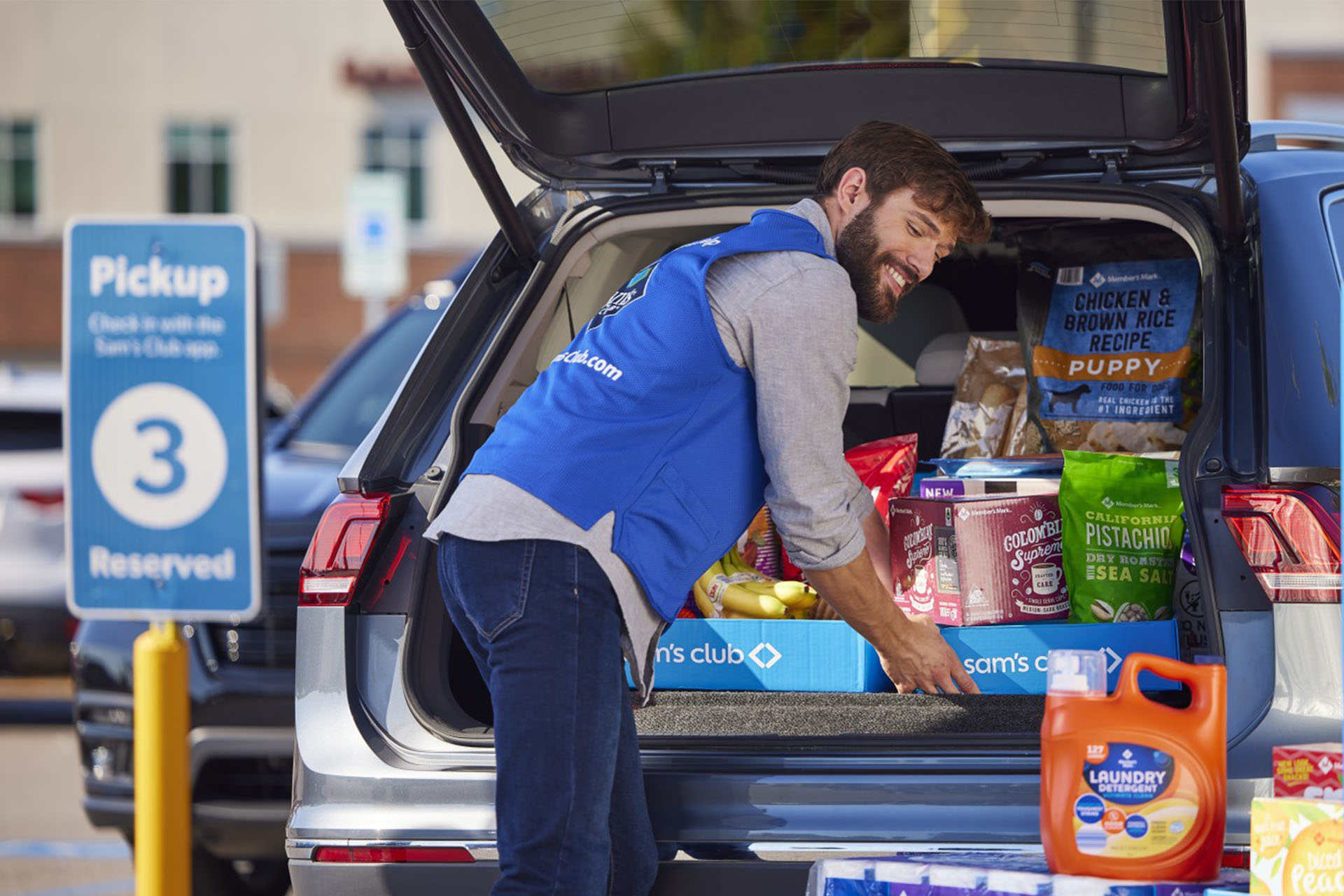
Sam’s Club curbside pickup
Sam’s is looking for all the ways it can make a building more productive in the omnichannel role, McLay said. A bigger format also gives Sam’s a place to consolidate health services, pharmacy, optical and hearing in one area, rather than their situation now as scattered through the clubs. The bigger format also provides more, and more attractive, space for fresh food including sushi counters, which already have proven successful despite less generous quarters.
Sam’s wants to lead on price. McKay said that means having the most competitive pricing in the club channel.
“So, we use data to scrape websites and we use third parties to collect prices. And personally, we’re out in the clubs ourselves to make sure on a basket of representative items across the nation, we have the best price points,” she said. “And so, we’ve worked actively over the last three years to invest to get ourselves in this position. We’re a highly competitive group. We know it’s important to our members. Value is important to them. It’s one of the reasons they pay to shop with us.”
Sam’s own Member’s Mark label is now an over $20 billion brand. Sam’s relaunched it last year based on member feedback about positioning the brand to better suit the customer and better serve the planet. Sam’s maintains a database of 40,000 members who are Member’s Mark shoppers located across the United States. They provide feedback on what they like and don’t like about the own brand’s emerging products. In essence, McLay said, Sam’s is designing Member’s Mark products with the customer, for the customer.
As regards the considerations regarding the planet, she said the general sentiment is particularly strong with younger members who are more attuned to environmental considerations. McLay said that Sam’s has established clear regenerative standards around products and that has gone over well with members, something she underscored by noting that the net promoter’s score for Member’s Mark has been advancing significantly.
However, developing Members Mark isn’t just about feedback but input in terms of investment in the products. McLay made the example of Sam’s floral buyer who has been spending time in Europe working on seeds and in Ecuador working with growers. In part, the effort is to address something Sam’s learned from member feedback: The customer wants longevity and abundance but they were also firm about wanting fragrance, and Sam’s, through its buyer, is working internationally to provide flowers that retain their scent longer.

Member’s Mark sea salt caramels
With only 5,500 SKUs in any club, Sam’s has worked to ensure each item has a story to tell based on how the company has worked to give the members what they want. Right now, Sam’s is looking at how to tell those stories digitally, McLay added.
With inflation coming down and even reversing in some segments, McLay says, getting the right price for the quality that Sam’s members expect is the critical point.
“We have seen the price has come down in general merchandise, and it’s a factor of both input costs as well as logistics supply chain costs normalizing. We’re investing heavily into quality, so we’re getting better quality brands into Sam’s Club,” she said.
Making It Easy
Although the price/quality balance is critical to the value proposition, McLay said convenience represents an additional opportunity for Sam’s as it does for Walmart, one that the club operation can serve with its omnichannel capabilities.
“We definitely saw convenience as being the place to differentiate versus the club channel,” she said. “So, when we started this journey back at the beginning of 2020, we decided that we needed to bring curbside to the club channel, and over the next six months, open it up across each of our operating units across the states. We have seen growth upon growth in that space. And we still see a very healthy horizon of growth for us in that space.
“Last year, we unlocked delivery,” McLay continued. “So, items in the club can now be delivered to the home. Between those channels, we’re seeing that there is not only growth in the future, but we’re profit-positive. So, our e-com, our omnichannel play is profit positive to us, which means that as we continue to grow in that space, it doesn’t become a drag on our P&L.”
McLay pointed out more than 70% of Sam’s omnichannel items come from a club whether shipped to a consumer’s home or handed over at pickup.
At the same time, Sam’s has been reconsidering merchandising to boost its effectiveness.
Over the past couple of years, McLay said, Sam’s has removed some items from its clubs as part of a purge of some shelves to create pallet flow displays.
Automation is a big topic in some parts of the Walmart organization, but Sam’s doesn’t need a significant boost when it comes to supply chain, she said. For the most part, merchandise is cross-docked. Where McLay said Sam’s needs automation is at the club level, where it is more heavily staffed. So Sam’s has invested in inventory scrubbers. The robotic devices clean floors while simultaneously taking inventory at Sam’s location.
As such, Sam’s gets a daily snapshot of what and where merchandise is in each of its clubs. Sam’s has been able to shift 35% of inventory tasks to automation and is looking to push that to 70% in the near future. Sam’s is shifting a mundane clerical task away from employees, who then can spend more time in member-facing work, McLay said. With Scan & Go added, Sam’s can put more employees in the position of helping customers and also into club-based fulfillment. She noted that Sam’s has enjoyed a 43% increase in top-line results over the past three years while holding the headcount at its clubs, with automation and digital assets contributing to making that happen.
In addition, the combination of automation and digital progress has given Sam’s the ability to raise wages. Better pay can mean better employee retention, which makes sense given, as is the case with Walmart stores, a more complex store environment means a bigger investment in training, which means the ROI is dependent on Sam’s ability to retain employees.
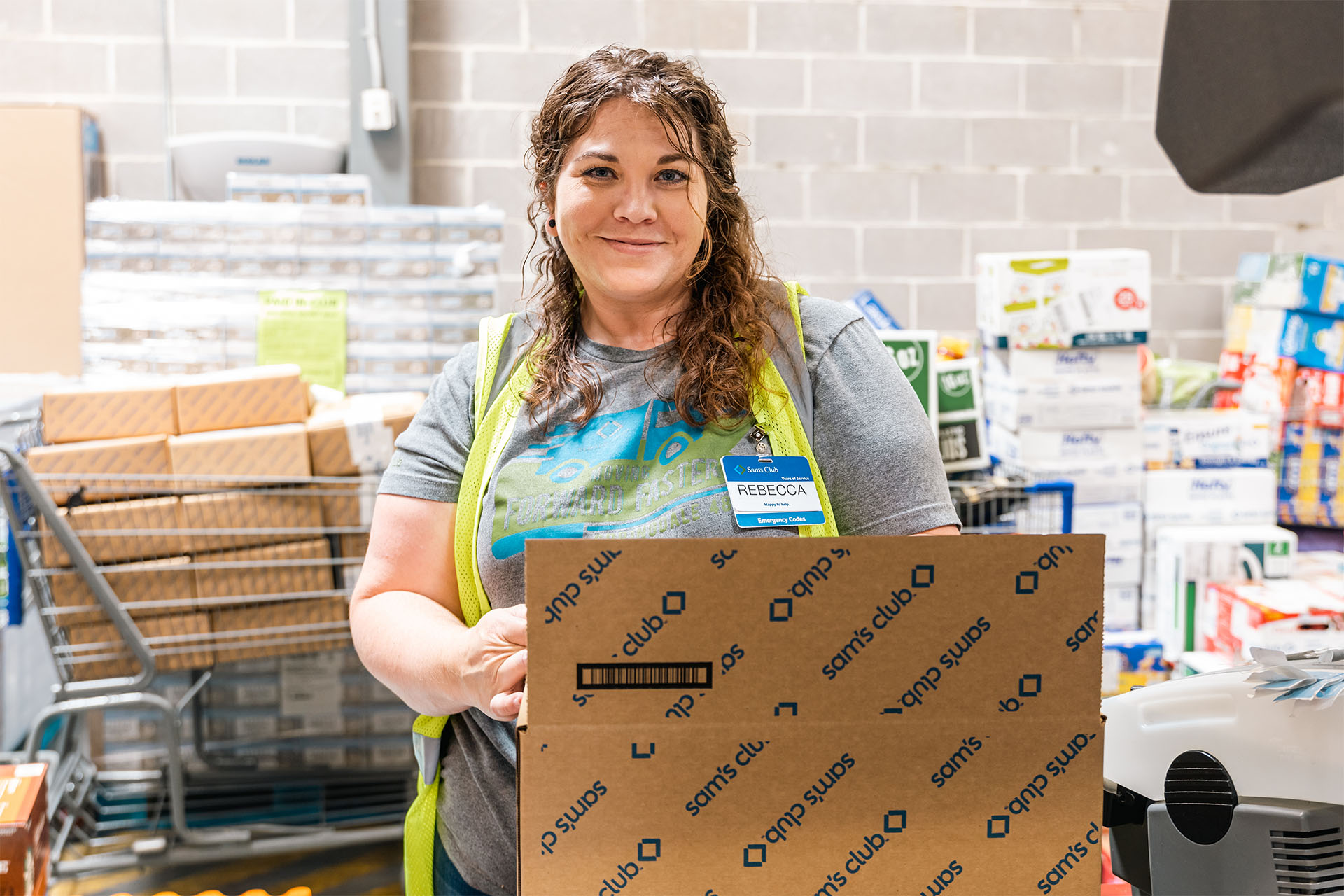
Sam’s Club associate prepares delivery from club
Today, McLay said, Sam’s starting wage for mainline workers is more than $15 an hour, and the average wage is about $19 an hour. As such, she said, Sam’s is highly competitive in the labor market and can provide employees with more satisfying jobs that employ technology they can use intuitively, especially with their smartphones.
At the same time, Sam’s brought inventory to a point where McLay called it clean for the present and going through the year. She also pointed out that the work that Sam’s is doing in stores, distribution and fulfillment should make product flow more efficient and reduce inventory costs longer term.
Changes at Sam’s are ongoing, McLay said, and while consumer-facing technology is more obvious, the use of data to inform operations is becoming ever more critical. The Scan & Go purchasing option has gained attention and creates some consistency in how members purchase in clubs and online.
Data has become a more important element in how Sam’s goes to market.
“We have really rich first-party data, which enables us to get very personalized in how we talk to each different person or cohort,” she said. “These are the capabilities we’ve been building out over the last couple of years. We’ve launched our digital ads business. We’ve stitched together online and offline sales. So our suppliers, when they present an ad to a member, can now find out: Did it trigger them to purchase online or did it trigger them to purchase the next time they’re in the club? The return on ad spend, the ROAS on that, has significantly lifted, which is really attractive to our supplier base.”
Scan & Go, Again
That ties back to Scan & Go.
“We’ve got a way to engage with our members who are shopping on Scan & Go in the club,” McLay said. “And we can present ads to them or we can just give them a nudge when they’re in the club around items that they may have forgotten to put into their basket or items that they may not have shopped previously, but we know because they behave like another member that they might like that item.
“We’re stitching together this digital ecosystem that enables us to engage differently with our member base, but also with our suppliers,” she continued. We’re kind of at that infancy stage where we’re just unlocking each of these capabilities. It’s taken us years to build it out. But we’re now at the point that we’re starting to play with all of those capabilities, and it’s exciting.”
In general, McLay maintained, the Sam’s gains reflect the satisfaction consumers have with its value proposition, which the banner can drive to even greater success.


